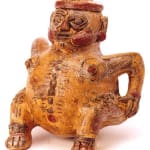Terracotta Polychrome Seated Figure, 500 CE - 1000 CE
Terracotta
5 x 6.5
PF.3857
Clay vessels and sculptures depicting individuals with deformities constitute a special genre. Figures with hunchbacks and pigeon breasts are quite common and are identified with shaman-priests who were partly admired...
Clay vessels and sculptures depicting individuals with deformities constitute a special genre. Figures with hunchbacks and pigeon breasts are quite common and are identified with shaman-priests who were partly admired for their particular deformity. There are others, such as this extraordinary figure, which exhibit external signs of disease, malformation or both. The bloated body of this person has the added misfortune of swellings in the form of pellets on the hips, wrists and feet, which may in fact be scars. His cheeks are puffed and colored a bright red, as are the tips of his breasts and belly button. His eyelids are swollen and stare with a poignant intensity. The hat he wears is very unusual, rimmed in red with a jaunty peak giving the impression it is made of cloth. Down the center of his stomach is a vertical series of black circles and a double row of short black horizontal lines. It is possible this figure represents individuals suffering from either one or a number of ailments and was used by a shaman/healer as a tangible object to 'absorb' the disease from the patient. This form of 'sympathetic' magic has been practiced for centuries in cultures around the world. Few examples, however, offer such vivid expression in a work of art that touches us so profoundly.



